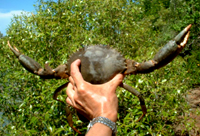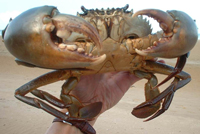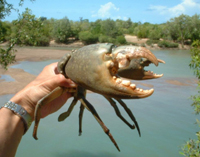 T-Pot MA960 New!
T-Pot MA960 New!  T-Pot MA860
T-Pot MA860
 T-Pot MA840
T-Pot MA840 T-Pot MA660
T-Pot MA660 T-Pot MA640
T-Pot MA640 T-Pot MA460
T-Pot MA460 T-Pot MA440
T-Pot MA440 T-Pot MA260
T-Pot MA260  T-Pot MA240
T-Pot MA240 CONTACT US
Mud crabs will scurry into the water or into a burrow if they encounter humans or large animals but they are certainly not timid crustaceans. Instinctively, they fight to defend themselves in two ways – using a pair of powerful pincers (nippers or claws) or their six sharp pointed legs. The Claws
One of the functions of their claws is for feeding. They are used to crush or crack bivalves like clams or oysters and tearing flesh from the shell or fish carcass. The claws also act like hands and fingers to pick up food to put into their mouth. A mature male mud crab had been spotted carrying away a can of punctured tuna cat food weighing 400g by pressing both circular ends with its claws. The powerful claws are also used as a weapon to defend themselves and they can reach out in unexpectedly high speeds. Juveniles, females and young male or mature male that are full of meat (muscles) are extremely agile with their claws. Once a claw grabs a finger or an object, the crab’s instinct is to drop it and try to escape. The abandoned claw will be tightly clamped to the finger or object as the muscles are contracted and it is very hard if not impossible to use the fingers pry open the grip. In such instance, using a pair of pliers to crush the pincers is the easiest way out. In the event where a pair of pliers is not available, like crabbing from the banks of estuaries with only light and essential gears, the next best thing to do is to use the teeth to crush the claw. Crushing the claw with an object like a piece of tree branch or rock is not recommended as it is difficult to get a precise blow to the claw in one strike and the impact may cause the saw-teeth like spines to cut deeper into the flesh or worst still, causing fragments of the shell to be imbedded. This will cause more pain and risk of infection to the wound. Anyone who has tried holding a clawless crab by the abdomen would realize the needle like sensation when the six sharp legs closed in on the hand. This is an attempt by the crab to free itself without the claws. They may not break the skin but they are painful enough to force the hand to let go or using the other hand to hold the crab in a more respectful manner from the back of the carapace. Holding a crab
The best way to hold an untied mud crab safely and preventing it from dropping its claws is by holding it from the back. The other of course is to grab it using a pair of crab tong. |
|
|
To hold the crab, use the thumb and the middle fingers to grip the base of the carapace near the hind swimming legs and using the first finger to press at the center of the shell to prevent the crab from flipping backwards. A crab that has just been released from the pot is very aggressive and alert and will quickly turn to face and grab at any object or hand that approaches it. Therefore, using a piece of wood to place firmly on top of the shell before holding it in the hand will be easier for an inexperienced crabber. Another way to get a crab under control after it is out of the pot is by using a piece of dark colored cloth, preferably black and soaked in water. Spread the wet cloth with two hands and throw it over the crab to cover the claws and eyes. Once the eyes are covered, it is disorientated and will calm down quickly. It is now safe to hold the crab from behind firmly and when it is sure that the claws are not grabbing the cloth, pull it away swiftly. It is important to note that even when the crab’s eyes are covered the claws will still nip a finger if touched. Similarly, it is useful to remember that crabs have nocturnal capability therefore they can see and react the same way in darkness as in the day. |
|



